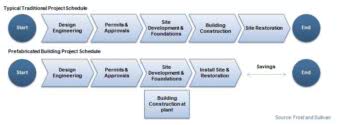
How Manufacturing is Helping the Construction Industry Face Its Challenges
By Prathmesh Limaye, Senior Research Analyst – Chemicals, Materials, Food, Frost & Sullivan
The construction industry is grappling with issues pertaining to productivity and meeting project deadlines that have been intensified following the economic recession of 2008-2009. About 2 million construction workers were let go in the United States alone between 2007 and 2011, and the industry has not been able to fill this vacuum during the recovery period. Additionally, with the impending BREXIT in Europe, the industry faces huge gaps in terms of skillsets. Such macro-economic trends hamper the growth of the construction industry as numerous timelines may be extended, leading to overall project delays.
How is the industry responding to these challenges?
The industry is adopting innovative techniques to overcome productivity challenges and is borrowing heavily from the manufacturing sector. The construction industry is now open to building homes in a factory off-site and installing the built homes onsite. The industry stakeholders are increasingly adopting such buildings, known as modular or prefabricated buildings, as these help them in completing projects in about half the time as traditional construction practices, leading to high savings.
The growth in adoption of modular and prefabricated building practices paves the way for increased automation in the construction industry, which otherwise relies on manual processes such as bricklaying, installation, and carpentry that depend heavily on skilled labour.
How is automation achieved?
The adoption of modular and prefabricated buildings has also led to the adoption of principles hitherto unutilized in the industry. One such principle is the Design for Manufacturing Assembly (DfMA). The DfMA process, which is increasingly being adopted by prefab manufacturers, enables them to have a stronger design plan compared to traditional construction. This, in turn, helps in achieving a shorter construction period.
This approach has also led to the increased adoption of the Building Information Management (BIM) systems that typically generate 3D design models for a building. The BIM systems effectively compute the time, materials used, and cost of materials used in constructing a building. Thus, BIM acts as an effective project management tool that allows industry stakeholders to better track and manage construction projects. Apart from tools such as DfMA and BIM, other tools are also being adopted that aim to make construction projects more effective in terms of cost and time parameters.
How does automation benefit the industry?
Automation helps in processing and installation of a variety of construction materials, including wood, composites, and plastics. These materials, when compared with traditional ones such as concrete and steel, are considered more sustainable. For instance, wood emits a lower amount of CO2 to the environment when compared with concrete and can also be replenished through afforestation and reforestation activities.
Thus, manufacturing and automation in the construction industry are also enabling sustainable building practices, which is a primary challenge.
What is next?
With the advent of new technologies, such as additive manufacturing (3D printing), which is rapidly being deployed in the manufacturing sector, one can witness the increasing use of 3D printing in building prototypes for homes. This will help in gaining a better understanding of designs amongst stakeholders and enable better change management while executing projects. In fact, the Swiss design firm Fuseproject and the construction technology firm Icon have developed a joint venture named New Story in Latin America to develop housing solutions for the homeless using 3D printing and developed a 350 sq. ft. concept model in May 2019.
As a result, the industry is also experiencing a transformation of the traditional business models where design companies are becoming the construction companies of the future. For instance, AutoDesk, a major design software company, recently acquired the US-based prefab company FactoryOS and has initiated its use in the construction industry.
About Frost & Sullivan
For over five decades, Frost & Sullivan has become world-renowned for its role in helping investors, corporate leaders and governments navigate economic changes and identify disruptive technologies, Mega Trends, new business models and companies to action, resulting in a continuous flow of growth opportunities to drive future success. Frost & Sullivan has explored this sector through research in the modular and prefabricated building materials space and how technologies are impacting the construction industry as a whole. For more information on this article, contact Jacqui Holmes [email protected].